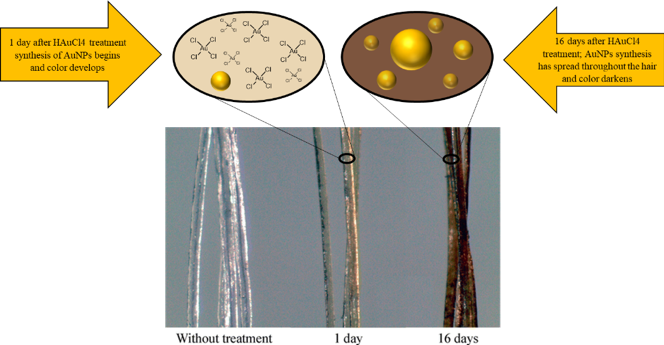Guess what? Your skin is the biggest organ in your body, with an area of 2m2 (pretty much the size of a beach towel)! Skin plays an important role in the protection of your muscles, bones, and organs, and acts as a physical barrier against pathogens. It also regulates your temperature, and when exposed to the sun, it synthesizes vitamin D, which promotes bone growth. Since it is the only organ completely exposed to the environment, we need to do our best to take care of it! So, how can nanotechnology help us nourish such an important part of our body?

As we get older, our skin gets more susceptible to sunburn, wrinkles, and dryness, and our hair becomes more damaged. Well, in the future and a store near you, nanotechnology could give us the skin care we deserve. Some skin care products already contain nanotechnology,1 including nanoparticles and nanocarriers2 (nanomaterials used to transport another substance, such as a drug or nutrient).
Companies are implementing nanotechnology in creams, lotions, and moisturizers as a new and effective approach to skin care, and the U.S. Food and Drug Administration (FDA) provides guidance for companies to make sure these products are safe.3 There are many examples of how nanotechnology is already improving our skincare products, and still much more to learn about their potential.
Improving Sunscreens
One example of nanotechnology being used in common products is the incorporation of titanium dioxide (TiO2) and zinc oxide (ZnO) nanoparticles in sunscreen. One of the reasons why these nanoparticles work well in this application is that they are not absorbed into the skin, making their cell toxicity risk very low.4 ZnO is better at blocking UVA and UVB rays, while TiO2 only blocks UVB and some short-wave UVA rays (see this blog post for more details).

The difference between UVA and UVB rays is that UVA penetrates the skin leading to premature ageing, skin discoloration and wrinkles; UVB only damages the surface of the skin but is harsher, leading to freckles, sun burns and cancer.4 As the use of these nanoparticles in sunscreens continue to grow commercially, it has become a concern that they may also lead to environmental and animal toxicity.
Some scientists have been researching alternative nanoparticles, like the naturally occurring nanoparticles from the English Ivy plant.6 These 70 nm, plant-based nanoparticles are made up of 19 different organic molecules and can block more UV rays than most metal oxide nanoparticles. So not only do we have an improved product, but also a sustainable, plant-based sunscreen! These nanoparticles also seem to be less damaging to human cells, making them safer to use for us and more eco-friendly.
Delivering molecules through the skin
Another type of skin care that uses nanotechnology is “nanocosmeceuticals.” Cosmeceuticals are products that have both cosmetic and therapeutic effects (cosmetics + pharmaceuticals = cosmeceutical).7 These products can contain essential nutrients like minerals, vitamins, and amino acids or contain other bioactive molecules (drugs) that are beneficial for us, which can also have a cosmetic outcome.8 It is important that these helpful materials can make it to their destination to perform their job and improve our skin, and that is where nanotechnology can come into play.

Nanotechnology can help provide controlled release of a substance, which means the drug can be gradually released into the skin in specific amounts throughout the day. In other words, with one application someone could receive continual treatment instead of having to reapply throughout the day. Another important benefit is that nanocosmeceuticals can also be designed to target specific tissues that need the drug delivery. The ability to penetrate the skin well means that nanocosmeceuticals can also be great at simply moisturizing our skin and preventing water loss.
A good example of a nanocosmeceutical is solid lipid nanoparticles (SLNs). A lipid is a biological molecule that has both a hydrophilic (water loving) head and a lipophilic (fat loving) tail. These are the same molecules that build the outsides of the cells in your body! Having both hydrophilic and hydrophobic parts means that lipids are great building blocks for nanoparticles.9 SLNs are generally spheres covered with an outside layer that allows the nanoparticle to easily penetrate the deeper layers of the skin. Inside this layer, the active ingredient is held in place by a solid lipid.10 These SLNs can be used for dermal drug and nutrient delivery to support healthy skin. The SLNs can be designed with different numbers of lipid layers, which enables the nanoparticles to penetrate deeper into the skin, move in between the cells, and release desired molecules on targeted locations.2,10

What is cool is that not only can SLNs repair damaged skin, but they can also help damaged or discolored hair! Some SLNs, like liposomes, are used for protein delivery with therapeutic benefits on skin elasticity and hair growth. These can vary from 25-2500 nm in size.11 In summary, there are a lot of different SLNs that are made up of different kinds of biological molecules that can build nanoparticles that can help in drug delivery through cosmetics. These can improve delivery of molecules through the skin for stronger, shinier and healthier hair since they can penetrate the skin better! Who wouldn’t want that?
Nanoparticles for hair color
For those who long to get the natural hair color they had when they were younger, you’ve been heard! A group of scientists has discovered that when they soaked white hair in chloroauric acid (HAuCl4, a chemical precursor to gold nanoparticles), the hair gradually darkened!12 This is because within the hair the gold chemical turns into gold nanoparticles, which gave the hair a darker color. One third of the global population uses permanent dyes, which can have a negative impact on one’s health.13 Aside from the gold from chloroauric acid, scientists have successfully used other nanoparticles to reduce the toxicity of permanent dyes by incorporating p-phenylenediamine (PDA, an ingredient widely used in hair dyes that can cause hypersensitivity reactions) into nanoparticles.14 This reduces the risk of PDA toxicity when in contact with the hair while the nanoparticle around this molecule protects sensitive skin cells from PDA exposure.

From drug delivery of pharmaceuticals to cosmetics and hair growth, nanotechnology has opened some amazing opportunities in skin care. Skin can experience a variety of damage, like sunburns, wrinkles, uneven complexion, dryness, even alopecia,15 and nanocosmeceuticals offer some promising results in repairing skin damage, applications in medicine delivery, and even new ways of coloring hair. Further studies are essential to fully understand the complexity of these nanocosmeceuticals and push the limits of what they can accomplish. But it seems clear that nanotechnology has potential for giving us healthier skin.

References
- Raj, S.; Shoma, J.; Sumod, U. S.; Sabitha, M. Nanotechnology in cosmetics: Opportunities and challenges. Journal of Pharmacy and Bioallied Sciences. 2012, 4, 186-193. doi: 10.4103/0975-7406.99016.
- Gupta, S.; Bansal, R; Gupta, S.; Jindal, N.; Jindal, A.; Nanocarriers and nanoparticles for skin care and dermatological treatments. Indian Dermatology Online Journal. 2013, 4, 267-272. doi: 10.4103/2229-5178.120635.
- Katz, L. M.; Dewan, K.; Bronaugh, R. L. Nanotechnology in cosmetics. Food and Chemical Toxicology. 2015, 85, 127–137. doi: 10.1016/j.fct.2015.06.020.
- TMDA. How your UV-protective sunscreen works.
- Lewicka, Z. et al. The structure, composition, and dimensions of TiO2 and ZnO nanomaterials in commercial sunscreens. Journal of Nanoparticle Research, 2011, 13 3607. Doi: 10.1007/s11051-011-0438-4
- Xia, L.; Lenaghan, S. C.; Zhang, M.; Zhang, Z.; Li, Q. Naturally occurring nanoparticles from English ivy: an alternative to metal-based nanoparticles for UV protection. Journal of Nanobiotechnology. 2010, 8, 12. doi: 10.1186/1477-3155-8-12
- Hunt, M. Cosmeceuticals, The Australiasian College of Dermatologists.
- Kaul, S.; Gulati, N.; Verma, D.; Mukherjee, S.; Nagaich, U. Role of Nanotechnology in Cosmeceuticals: A Review of Recent Advances. Journal of Pharmaceutics, 2018, 3420204. doi: 10.1155/2018/3420204
- Mashaghi, S.; Jadidi, T.; Koenderink, G.; Mashaghi, A. Lipid Nanotechnology. International Journal of Molecular Sciences. 2013, 14, 4242–4282. doi: 10.3390/ijms14024242.
- Uchechi, O.; Ogbonna, J. D. N.; Attama, A. A. Nanoparticles for dermal and transdermal drug delivery. In Applications of Nanotechnology in Drug Delivery. 2014. doi: 10.5772/58672
- Akbarzadeh, A.; Rezaei-Sadabady, R.; Davaran, S.; Joo, S. W.; Zarghami, N.; Hanifehpour, Y.; Samiei, M.; Kouhi, M.; Nejati-Koshki, K. Liposome: classification, preparation, and applications. Nanoscale Research Letters. 2013, 8, 102. doi: 10.1186/1556-276X-8-102.
- Haveli, Shrutisagar D; Walter, P.; Patriarche G.; Ayache, J; Castaing, J.; Van Elslande, E.; Tsoucaris, G.; Wang, P-A.; Kagan, H. B. Hair fiber as a nanoreactor in controlled synthesis of fluorescent gold nanoparticles. Nano letters, 12, 6212-6217. doi: 10.1021/nl303107w
- Rosen, J.; Landriscina, A.; Friedman, A. J. Nanotechnology-based cosmetics for hair care. Cosmetics, 2015, 2, 211–224. doi: 10.3390/cosmetics2030211
- Lee, H.-Y.; Jeong, Y.-I.; Kim, D.-H.; Choi, K.-C. Permanent hair dye-incorporated hyaluronic acid nanoparticles. Journal Microencapsulation. 2013, 30, 189–197. doi: 10.3109/02652048.2012.714412
- Pereira, M. N.; Ushirobira, C. Y.; Cunha-Filho, M. S.; Gelfuso, G. M.; Gratieri, T. Nanotechnology advances for hair loss. Therapeutic Delivery, 2018, 9, 593–603. doi: 10.4155/tde-2018-0025.
